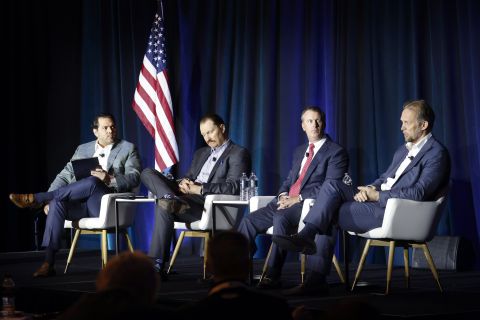
Nexans will deliver an innovative 32-km-long umbilical, combining power, signal and steel tubes as well as other services to OneSubsea and Woodside in Western Australia. (Source: Nexans)
The advance of E&P into ever deeper waters, the increasing length of step-outs and the growing number of satellite developments from mature fields indicate that in coming years umbilicals will play an even more important role in offshore oil and gas production.
They provide the link from the host facility through which control is exercised, power transmitted and utilities such as injection chemicals supplied to the subsea wells.
Typically they range in length from a few kilometers to well over 100 km (62 miles), but future projects are expected to see umbilicals reaching lengths of more than 200 km (124 miles) and possibly even longer. The multiple functions it performs, the extreme reliability required and the demanding environment in which it is installed and operates, make an umbilical an extremely high-tech product.
The burgeoning electrification on the seabed is heralding a new era for umbilicals with less hydraulics required countered by a growing need for medium and high voltage.
“This trend has been in the industry for some time, but now everybody is talking about all-electric as being the near future,” said Jon Arne Hall, Nexans’ technical project engineering director. “This will reduce the number of super duplex tubes in an umbilical.”
Flow Assurance
The move to deeper water with longer subsea tiebacks is causing new potential flow assurance challenges for operators, particularly in deepwater where low temperature and high pressure at the ocean floor increases chances of hydrate and wax formation, blocking the flow of oil and gas.
“It is common to prevent hydrate and wax formation by injecting chemicals into the well stream, but this is not always the most beneficial method seen from a technical, cost and environmental perspective,” Hall said.
With the push to improve operational efficiency, topside space is valuable while feeding the chemical processing equipment is very costly. To develop an alternative, a joint industry project (JIP) was formed by Nexans, Statoil and the research organization Sintef, to evaluate alternative methods of flow assurance. The outcome of the JIP was direct electrical heating (DEH), a technology which was qualified in 1998.
Hall explained that the DEH system heats the flowline above the temperature at which hydrate formation takes place by applying AC to the pipeline. This is supplied via the riser cable from the topside power system. Down on the seabed, the cable is connected to the subsea junction box. Another advantage is that the DEH riser cable can be used to bring down other service lines, such as signal and power cables, or additional fiber optics to the subsea junction box. A coaxial feeder cable is used between the subsea junction box and the pipeline.
At the pipeline the outer conductor in the cable is connected to the flowline, while the inner conductor is joined to a single core piggyback cable, which is attached to the flowline along the entire length to be heated and connected at the far end. The flowline then becomes the primary return conductor in the system, which is heated by its own electrical resistance.
At each end of the flowline, where the current is transferred between the pipe and cable, additional sacrificial anodes are mounted to form a well-defined, low-impedance path for the current to the sea, known as the current transfer zone. This makes it an open system, which improves safety and reliability. The anodes are rated for both corrosion protection and sufficient grounding of the system during the designed lifetime of the flowline and the heating system. The AC does not influence the internal corrosion of the flowline.
Future For DEH
Nexans has delivered nine out of 10 DEH systems that are in operation. The first DEH system was installed on the Åsgard Field, operated by Statoil, in 2000. The longest pipeline with DEH technology in operation is Tyrihans, also operated by Statoil. The production line is an 18-in. diameter, 42-km (26-mile) pipeline. The system installed at Tyrihans was the first installation with fiber used for break detection, another Nexans patent.
Hall believes the current developments in the deepwater oil field will make the DEH product more attractive.
“DEH systems react instantly if an unplanned shutdown occurs and are simple to use,” he said. “The systems have the additional advantage of being environmentally friendly. Each DEH system is tailored to the needs of the individual project. While the longest individual piggyback cable to date has been 42 km long, Nexans has the technology and know-how to significantly increase the length in future projects.
“The piggyback cable has been developed and qualified down to a water depth of 1,070 m [3,511 ft], but this depth is set to be increased in the future.”
Recommended Reading
Texas Capital Navigates the Trends Shifting Financial Markets
2024-10-18 - Texas Capital has had to navigate trends impacting the financial markets, such as an emphasis on ESG and less-than-favorable equity markets, said Daniel Hoverman, Texas Capital's head of corporate and investment banking, at ECC.
No Rush: Post-M&A Frenzy, Divestiture Market to Pick Up by 2025
2024-10-07 - Lenders with a variety of capital structures are poised to fund the upcoming portfolio rationalization in the post-consolidation era, bankers and deal advisers said at Hart Energy’s Energy Capital Conference.
Exclusive: Why Family Offices Favor ‘Lower-Risk’ Oil, Gas Investments
2024-11-22 - Evan Smith, Stephens’ senior vice president for investment banking, describes growth in the company’s network of family offices, specifically those investing in the energy sector, in this Hart Energy Exclusive interview.
Quantum’s VanLoh: New ‘Wave’ of Private Equity Investment Unlikely
2024-10-10 - Private equity titan Wil VanLoh, founder of Quantum Capital Group, shares his perspective on the dearth of oil and gas exploration, family office and private equity funding limitations and where M&A is headed next.
Energy Sector Sees Dramatic Increase in Private Equity Funding
2024-11-21 - In a 10-day period, private equity firms announced almost $20 billion in energy funding. Is an end in sight for the fossil fuel capital drought?
Comments
Add new comment
This conversation is moderated according to Hart Energy community rules. Please read the rules before joining the discussion. If you’re experiencing any technical problems, please contact our customer care team.






